The Cambridge History of Japan, Vol. 1: Ancient Japan
Подождите немного. Документ загружается.

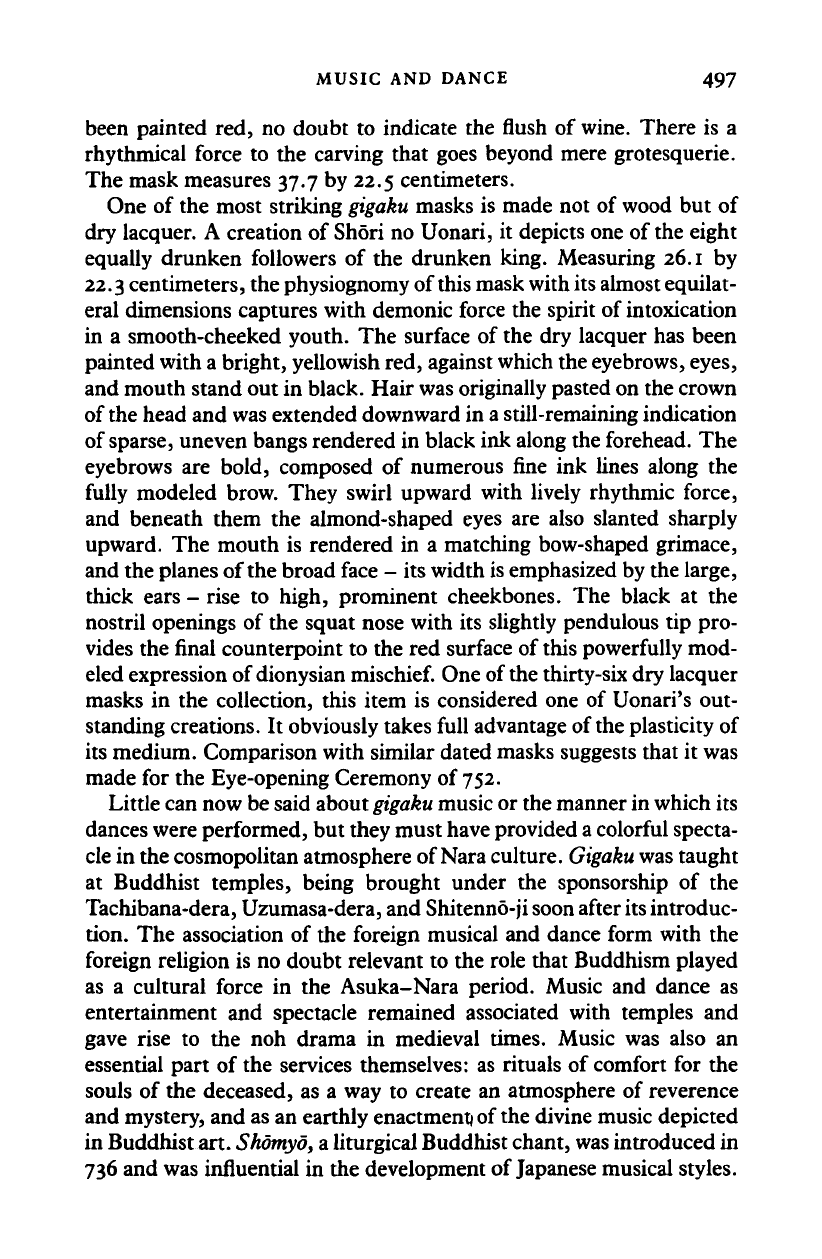
MUSIC AND DANCE 497
been painted red, no doubt to indicate the flush of wine. There is a
rhythmical force to the carving that goes beyond mere grotesquerie.
The mask measures 37.7 by 22.5 centimeters.
One of the most striking
gigaku
masks is made not of wood but of
dry lacquer. A creation of Shod no Uonari, it depicts one of the eight
equally drunken followers of the drunken king. Measuring 26.1 by
22.3
centimeters, the physiognomy of this mask with its almost equilat-
eral dimensions captures with demonic force the spirit of intoxication
in a smooth-cheeked youth. The surface of the dry lacquer has been
painted with
a
bright, yellowish red, against which the eyebrows, eyes,
and mouth stand out in black. Hair was originally pasted on the crown
of
the
head and was extended downward in a still-remaining indication
of
sparse,
uneven bangs rendered in black ink along the forehead. The
eyebrows are bold, composed of numerous fine ink lines along the
fully modeled brow. They swirl upward with lively rhythmic force,
and beneath them the almond-shaped eyes are also slanted sharply
upward. The mouth is rendered in a matching bow-shaped grimace,
and the planes of the broad face - its width is emphasized by the large,
thick ears - rise to high, prominent cheekbones. The black at the
nostril openings of the squat nose with its slightly pendulous tip pro-
vides the final counterpoint to the red surface of this powerfully mod-
eled expression of dionysian
mischief.
One of
the
thirty-six dry lacquer
masks in the collection, this item is considered one of Uonari's out-
standing creations. It obviously takes full advantage of
the
plasticity of
its medium. Comparison with similar dated masks suggests that it was
made for the Eye-opening Ceremony of 752.
Little can now be said about
gigaku
music or the manner in which its
dances were performed, but they must have provided
a
colorful specta-
cle in the cosmopolitan atmosphere of Nara
culture.
Gigaku
was taught
at Buddhist temples, being brought under the sponsorship of the
Tachibana-dera, Uzumasa-dera, and Shitenno-ji soon after
its
introduc-
tion. The association of the foreign musical and dance form with the
foreign religion is no doubt relevant to the role that Buddhism played
as a cultural force in the Asuka-Nara period. Music and dance as
entertainment and spectacle remained associated with temples and
gave rise to the noh drama in medieval times. Music was also an
essential part of the services themselves: as rituals of comfort for the
souls of the deceased, as a way to create an atmosphere of reverence
and mystery, and as an earthly enactment) of the divine music depicted
in Buddhist an.
Shomyo,
a liturgical Buddhist chant,
was
introduced in
736 and was influential in the development of Japanese musical styles.
Cambridge Histories Online © Cambridge University Press, 2008
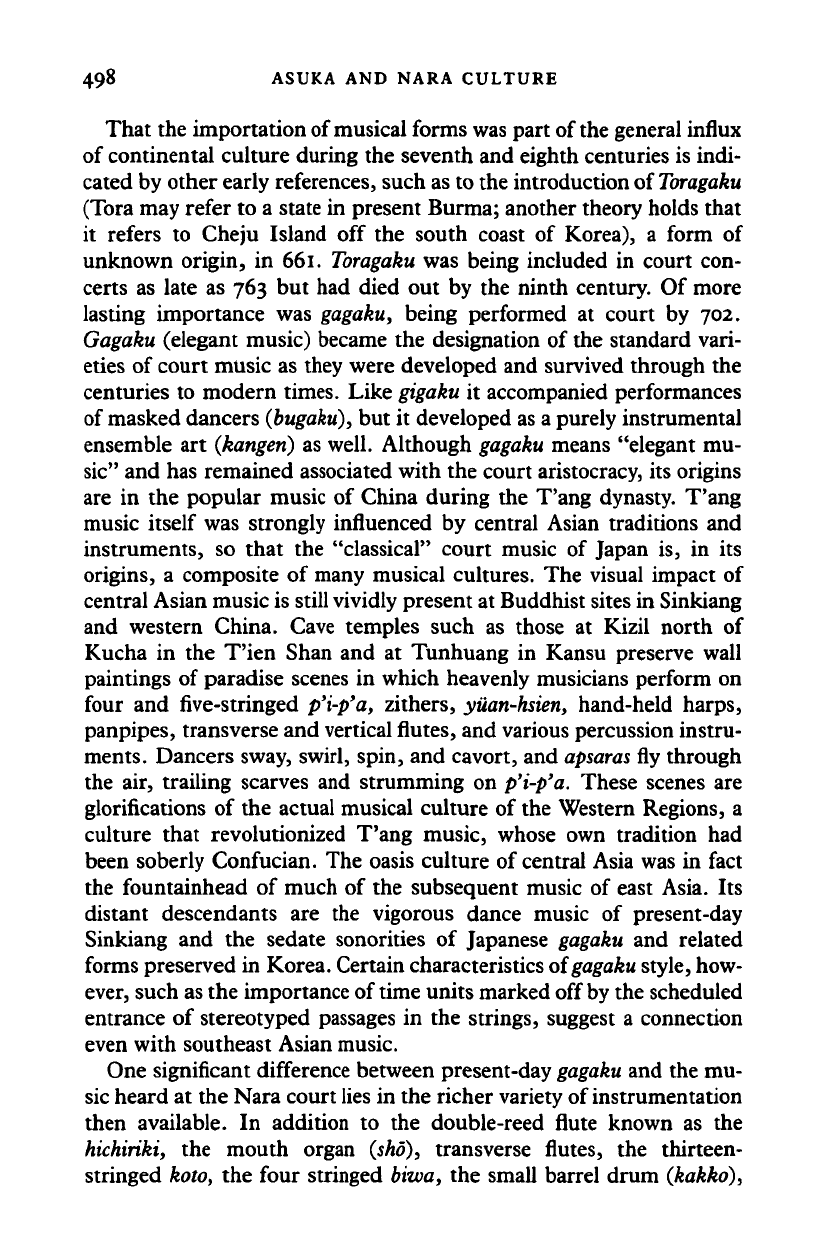
498 ASUKA AND NARA CULTURE
That the importation of musical forms was part of the general influx
of continental culture during the seventh and eighth centuries is indi-
cated by other early references, such as to the introduction of
Toragaku
(Tora may refer to a state in present Burma; another theory holds that
it refers to Cheju Island off the south coast of Korea), a form of
unknown origin, in 661.
Toragaku
was being included in court con-
certs as late as 763 but had died out by the ninth century. Of more
lasting importance was gagaku, being performed at court by 702.
Gagaku (elegant music) became the designation of the standard vari-
eties of court music as they were developed and survived through the
centuries to modern times. Like
gigaku
it accompanied performances
of masked dancers
(Jbugaku),
but it developed as a purely instrumental
ensemble art
(kangeri)
as well. Although
gagaku
means "elegant mu-
sic"
and has remained associated with the court aristocracy, its origins
are in the popular music of China during the T'ang dynasty. T'ang
music itself was strongly influenced by central Asian traditions and
instruments, so that the "classical" court music of Japan is, in its
origins, a composite of many musical cultures. The visual impact of
central Asian music is still vividly present at Buddhist sites in Sinkiang
and western China. Cave temples such as those at Kizil north of
Kucha in the T'ien Shan and at Tunhuang in Kansu preserve wall
paintings of paradise scenes in which heavenly musicians perform on
four and five-stringed
p'i-p'a,
zithers,
yiian-hsien,
hand-held harps,
panpipes, transverse and vertical flutes, and various percussion instru-
ments. Dancers sway, swirl, spin, and cavort, and
apsaras
fly
through
the air, trailing scarves and strumming on
p'i-p'a.
These scenes are
glorifications of the actual musical culture of the Western Regions, a
culture that revolutionized T'ang music, whose own tradition had
been soberly Confucian. The oasis culture of central Asia was in fact
the fountainhead of much of the subsequent music of east Asia. Its
distant descendants are the vigorous dance music of present-day
Sinkiang and the sedate sonorities of Japanese gagaku and related
forms preserved in Korea. Certain characteristics of
gagaku
style, how-
ever, such as the importance of
time
units marked off by the scheduled
entrance of stereotyped passages in the strings, suggest a connection
even with southeast Asian music.
One significant difference between present-day
gagaku
and the mu-
sic heard at the Nara court lies in the richer variety of instrumentation
then available. In addition to the double-reed flute known as the
hichiriki, the mouth organ (sho), transverse flutes, the thirteen-
stringed
koto,
the four stringed biwa, the small barrel drum (kakko),
Cambridge Histories Online © Cambridge University Press, 2008
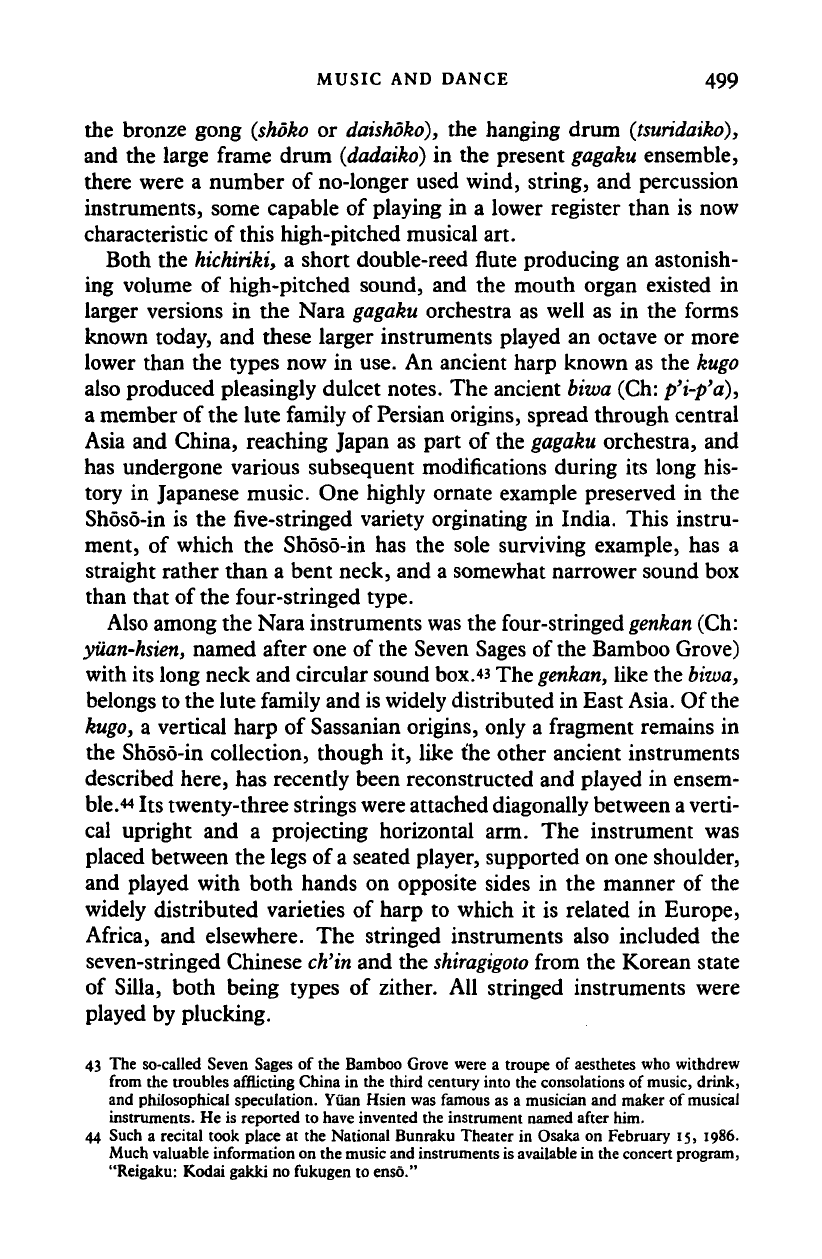
MUSIC AND DANCE 499
the bronze gong
(shoko
or
daishoko),
the hanging drum
(tsuridaiko),
and the large frame drum
(dadaiko)
in the present
gagaku
ensemble,
there were a number of no-longer used wind, string, and percussion
instruments, some capable of playing in a lower register than is now
characteristic of this high-pitched musical art.
Both the
hichiriki,
a short double-reed flute producing an astonish-
ing volume of high-pitched sound, and the mouth organ existed in
larger versions in the Nara
gagaku
orchestra as well as in the forms
known today, and these larger instruments played an octave or more
lower than the types now in use. An ancient harp known as the
kugo
also produced pleasingly dulcet notes. The ancient
biwa
(Ch:
p'i-p'a),
a member of the lute family of Persian origins, spread through central
Asia and China, reaching Japan as part of the
gagaku
orchestra, and
has undergone various subsequent modifications during its long his-
tory in Japanese music. One highly ornate example preserved in the
Shdsd-in is the five-stringed variety orginating in India. This instru-
ment, of which the Shoso-in has the sole surviving example, has a
straight rather than a bent neck, and a somewhat narrower sound box
than that of the four-stringed type.
Also among the Nara instruments was the four-stringed
genkan
(Ch:
yiian-hsien,
named after one of the Seven Sages of the Bamboo Grove)
with its long neck and circular sound box.« The
genkan,
like the biwa,
belongs to the lute family and is widely distributed in East Asia. Of the
kugo,
a vertical harp of Sassanian origins, only a fragment remains in
the Shosd-in collection, though it, like the other ancient instruments
described here, has recently been reconstructed and played in ensem-
ble.^
Its twenty-three strings were attached diagonally between
a
verti-
cal upright and a projecting horizontal arm. The instrument was
placed between the legs of
a
seated player, supported on one shoulder,
and played with both hands on opposite sides in the manner of the
widely distributed varieties of harp to which it is related in Europe,
Africa, and elsewhere. The stringed instruments also included the
seven-stringed Chinese
ch'in
and the
shiragigoto
from the Korean state
of Silla, both being types of zither. All stringed instruments were
played by plucking.
43
The
so-called Seven Sages
of the
Bamboo Grove were
a
troupe
of
aesthetes
who
withdrew
from
the
troubles afflicting China
in the
third century into
the
consolations
of
music,
drink,
and philosophical speculation. Yuan Hsien
was
famous
as a
musician
and
maker
of
musical
instruments.
He is
reported
to
have invented
the
instrument named after
him.
44 Such
a
recital took place
at the
National Bunraku Theater
in
Osaka
on
February
15, 1986.
Much valuable information
on the
music and instruments is available
in
the concert program,
"Reigaku: Kodai gakki
no
fukugen
to
enso."
Cambridge Histories Online © Cambridge University Press, 2008
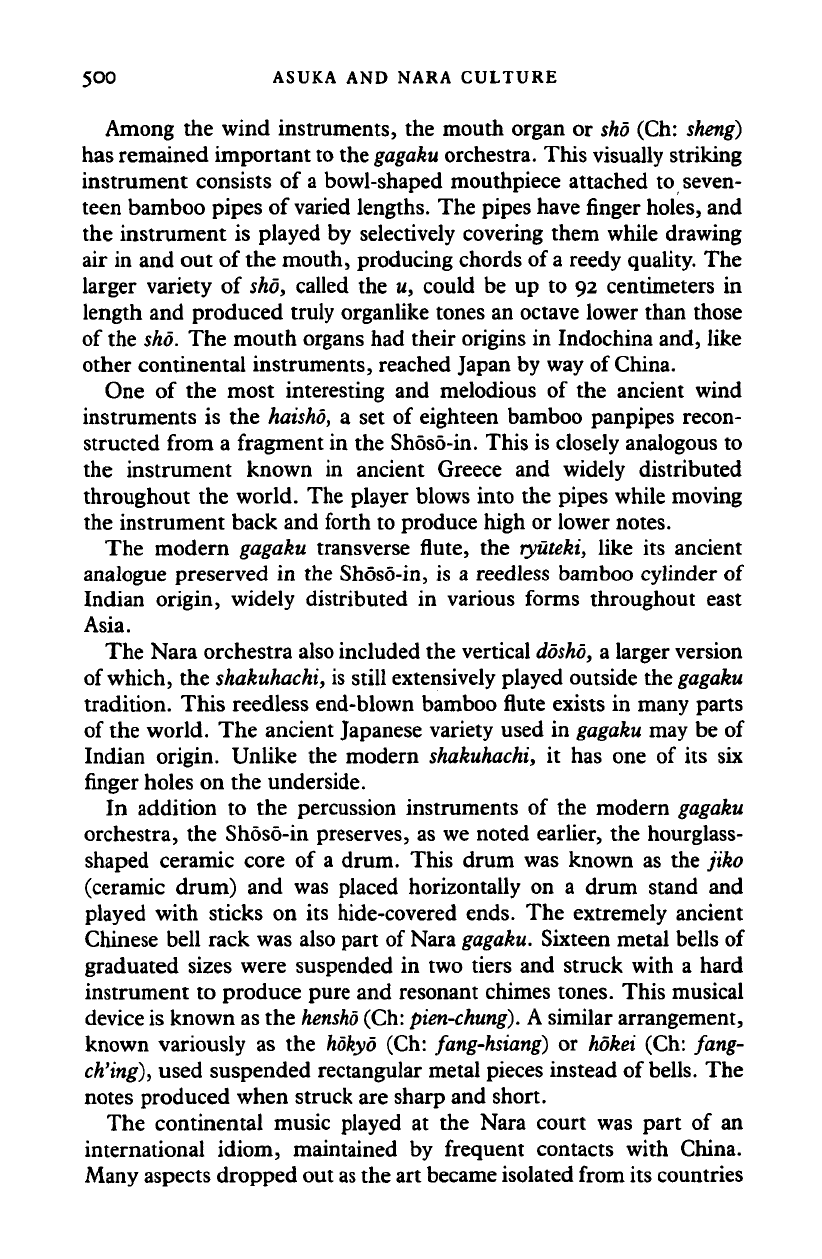
5O0 ASUKA AND NARA CULTURE
Among the wind instruments, the mouth organ or
sho
(Ch:
sheng)
has remained important to the
gagaku
orchestra. This visually striking
instrument consists of a bowl-shaped mouthpiece attached to seven-
teen bamboo pipes of varied lengths. The pipes have finger holes, and
the instrument is played by selectively covering them while drawing
air in and out of the mouth, producing chords of
a
reedy quality. The
larger variety of
sho,
called the u, could be up to 92 centimeters in
length and produced truly organlike tones an octave lower than those
of the
sho.
The mouth organs had their origins in Indochina and, like
other continental instruments, reached Japan by way of China.
One of the most interesting and melodious of the ancient wind
instruments is the
haishd,
a set of eighteen bamboo panpipes recon-
structed from a fragment in the Shoso-in. This is closely analogous to
the instrument known in ancient Greece and widely distributed
throughout the world. The player blows into the pipes while moving
the instrument back and forth to produce high or lower notes.
The modern gagaku transverse flute, the ryuteki, like its ancient
analogue preserved in the Shoso-in, is a reedless bamboo cylinder of
Indian origin, widely distributed in various forms throughout east
Asia.
The Nara orchestra also included the vertical
dosho,
a larger version
of which, the
shakuhachi,
is still extensively played outside the
gagaku
tradition. This reedless end-blown bamboo flute exists in many parts
of the world. The ancient Japanese variety used in
gagaku
may be of
Indian origin. Unlike the modern
shakuhachi,
it has one of its six
finger holes on the underside.
In addition to the percussion instruments of the modern gagaku
orchestra, the Shoso-in preserves, as we noted earlier, the hourglass-
shaped ceramic core of a drum. This drum was known as the jiko
(ceramic drum) and was placed horizontally on a drum stand and
played with sticks on its hide-covered ends. The extremely ancient
Chinese bell rack was also part of Nara
gagaku.
Sixteen metal bells of
graduated sizes were suspended in two tiers and struck with a hard
instrument to produce pure and resonant chimes tones. This musical
device is known as the
hensho
(Ch:
pien-chung).
A similar arrangement,
known variously as the
hokyo
(Ch:
fang-hsiang)
or hokei (Ch: fang-
ch'ing),
used suspended rectangular metal pieces instead of
bells.
The
notes produced when struck are sharp and short.
The continental music played at the Nara court was part of an
international idiom, maintained by frequent contacts with China.
Many aspects dropped out
as
the art became isolated from its countries
Cambridge Histories Online © Cambridge University Press, 2008
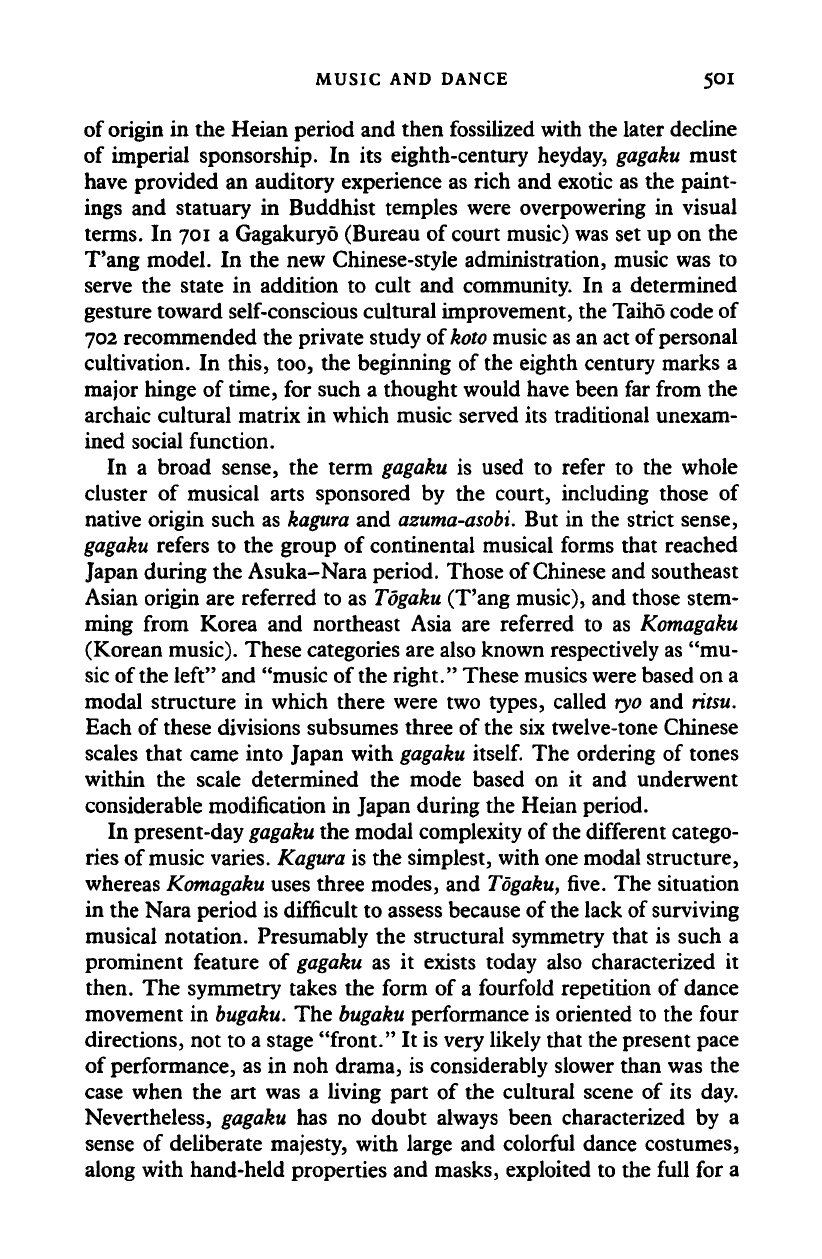
MUSIC AND DANCE 501
of origin in the Heian period and then fossilized with the later decline
of imperial sponsorship. In its eighth-century heyday,
gagaku
must
have provided an auditory experience as rich and exotic as the paint-
ings and statuary in Buddhist temples were overpowering in visual
terms.
In 701 a Gagakuryo (Bureau of court music) was set up on the
T'ang model. In the new Chinese-style administration, music was to
serve the state in addition to cult and community. In a determined
gesture toward self-conscious cultural improvement, the Taiho code of
702 recommended the private study of
koto
music as an act of personal
cultivation. In this, too, the beginning of the eighth century marks a
major hinge of time, for such a thought would have been far from the
archaic cultural matrix in which music served its traditional unexam-
ined social function.
In a broad sense, the term gagaku is used to refer to the whole
cluster of musical arts sponsored by the court, including those of
native origin such as
kagura
and
azwna-asobi.
But in the strict sense,
gagaku
refers to the group of continental musical forms that reached
Japan during the Asuka-Nara period. Those of Chinese and southeast
Asian origin are referred to as
Togaku
(T'ang music), and those stem-
ming from Korea and northeast Asia are referred to as Komagaku
(Korean music). These categories are also known respectively as "mu-
sic of the left" and "music of
the
right." These musics were based on a
modal structure in which there were two types, called
ryo
and ritsu.
Each of these divisions subsumes three of the six twelve-tone Chinese
scales that came into Japan with
gagaku
itself.
The ordering of tones
within the scale determined the mode based on it and underwent
considerable modification in Japan during the Heian period.
In present-day
gagaku
the modal complexity of the different catego-
ries of music varies.
Kagura
is the simplest, with one modal structure,
whereas
Komagaku
uses three modes, and
Togaku,
five.
The situation
in the Nara period is difficult to assess because of
the
lack of surviving
musical notation. Presumably the structural symmetry that is such a
prominent feature of
gagaku
as it exists today also characterized it
then. The symmetry takes the form of a fourfold repetition of dance
movement in
bugaku.
The
bugaku
performance is oriented to the four
directions, not to a stage "front." It is very likely that the present pace
of performance, as in noh drama, is considerably slower than was the
case when the art was a living part of the cultural scene of its day.
Nevertheless, gagaku has no doubt always been characterized by a
sense of deliberate majesty, with large and colorful dance costumes,
along with hand-held properties and masks, exploited to the full for a
Cambridge Histories Online © Cambridge University Press, 2008
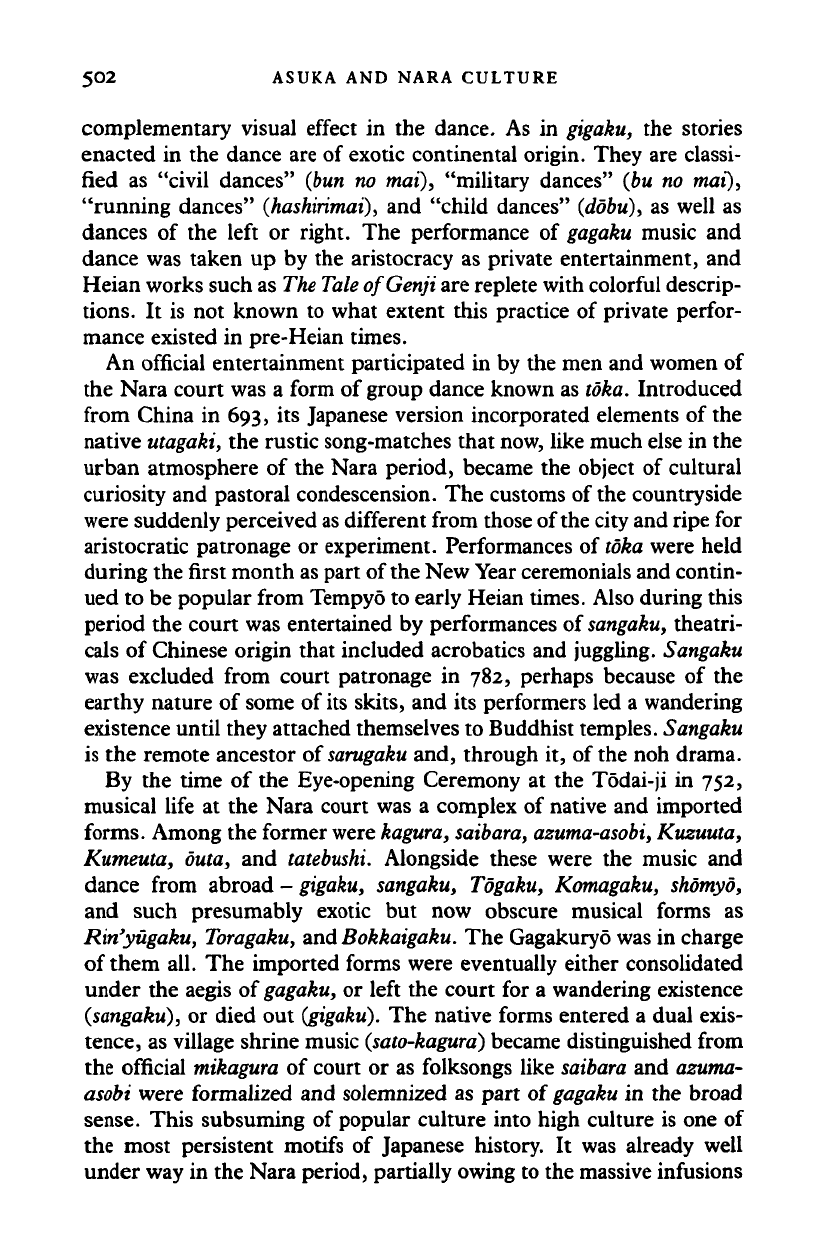
502 ASUKA AND NARA CULTURE
complementary visual effect in the dance. As in
gigaku,
the stories
enacted in the dance are of exotic continental origin. They are classi-
fied as "civil dances" (bun no mat), "military dances" (bu no mat),
"running dances"
(hashirimai),
and "child dances"
(dobu),
as well as
dances of the left or right. The performance of
gagaku
music and
dance was taken up by the aristocracy as private entertainment, and
Heian works such as
The Tale
of
Genii
are replete with colorful descrip-
tions.
It is not known to what extent this practice of private perfor-
mance existed in pre-Heian times.
An official entertainment participated in by the men and women of
the Nara court was a form of group dance known as
toka.
Introduced
from China in 693, its Japanese version incorporated elements of the
native
utagaki,
the rustic song-matches that now, like much else in the
urban atmosphere of the Nara period, became the object of cultural
curiosity and pastoral condescension. The customs of the countryside
were suddenly perceived
as
different from those of the city and ripe for
aristocratic patronage or experiment. Performances of
toka
were held
during the first month as part of the New Year ceremonials and contin-
ued to be popular from Tempyo to early Heian times. Also during this
period the court was entertained by performances of
sangaku,
theatri-
cals of Chinese origin that included acrobatics and juggling. Sangaku
was excluded from court patronage in 782, perhaps because of the
earthy nature of some of its skits, and its performers led a wandering
existence until they attached themselves to Buddhist temples. Sangaku
is the remote ancestor of
sarugaku
and, through it, of the noh drama.
By the time of the Eye-opening Ceremony at the Todai-ji in 752,
musical life at the Nara court was a complex of native and imported
forms.
Among the former were
kagura,
saibara,
azuma-asobi,
Kuzuuta,
Kumeuta, buta, and
tatebushi.
Alongside these were the music and
dance from abroad -
gigaku,
sangaku, Togaku, Komagaku, shomyo,
and such presumably exotic but now obscure musical forms as
Rin'yugaku,
Toragaku,
and
Bokkaigaku.
The Gagakuryo was in charge
of them all. The imported forms were eventually either consolidated
under the aegis of
gagaku,
or left the court for a wandering existence
(sangaku),
or died out
(gigaku).
The native forms entered a dual exis-
tence, as village shrine music
(sato-kagura)
became distinguished from
the official
mikagura
of court or as folksongs like
saibara
and azuma-
asobi
were formalized and solemnized as part of
gagaku
in the broad
sense. This subsuming of popular culture into high culture is one of
the most persistent motifs of Japanese history. It was already well
under way in the Nara period, partially owing to the massive infusions
Cambridge Histories Online © Cambridge University Press, 2008
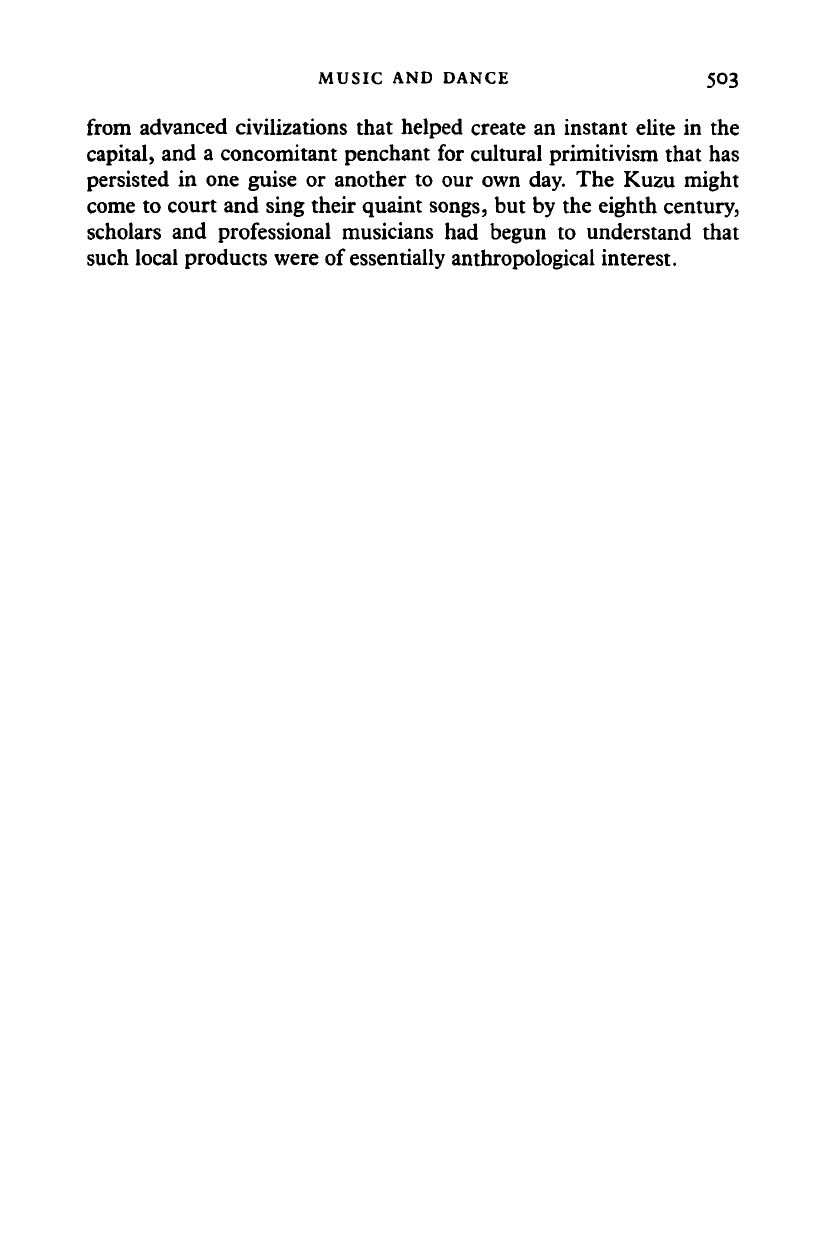
MUSIC AND DANCE 503
from advanced civilizations that helped create an instant elite in the
capital, and a concomitant penchant for cultural primitivism that has
persisted in one guise or another to our own day. The Kuzu might
come to court and sing their quaint songs, but by the eighth century,
scholars and professional musicians had begun to understand that
such local products were of essentially anthropological interest.
Cambridge Histories Online © Cambridge University Press, 2008
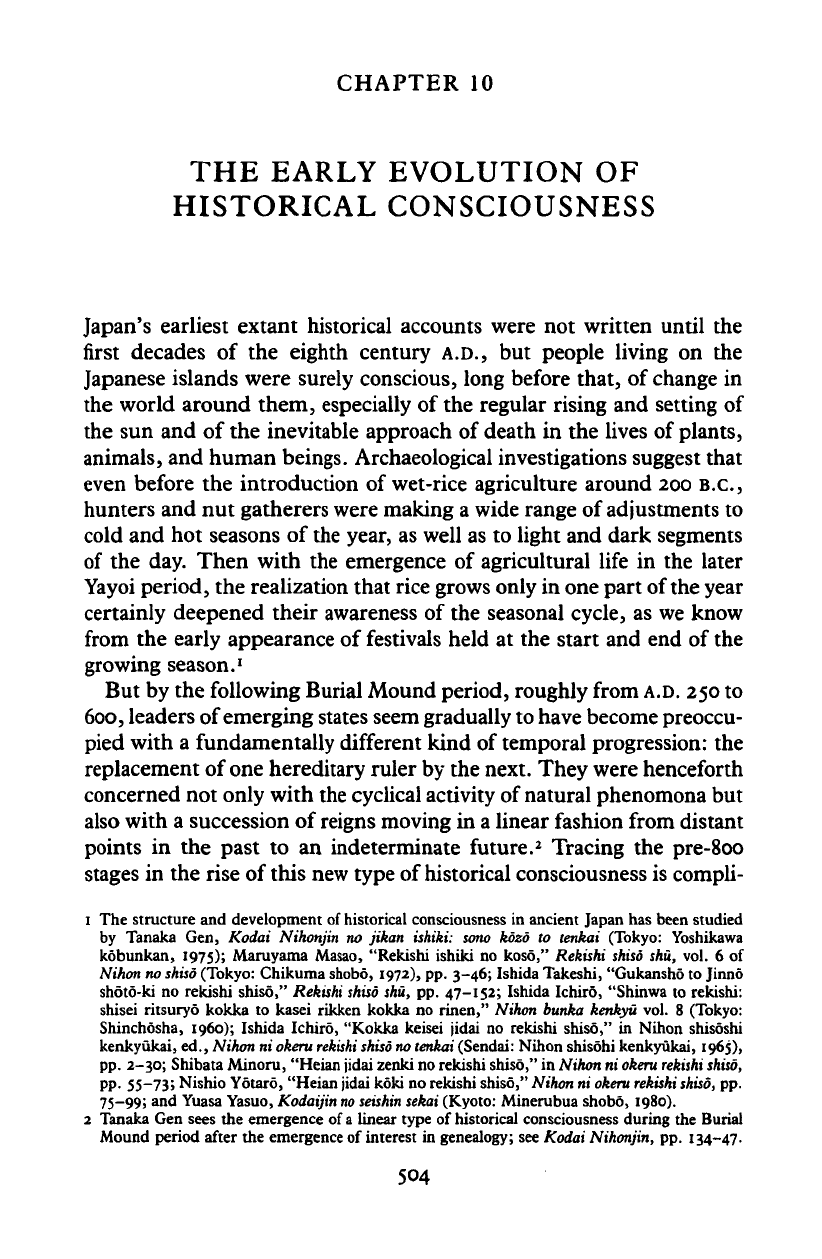
CHAPTER 10
THE EARLY EVOLUTION OF
HISTORICAL CONSCIOUSNESS
Japan's earliest extant historical accounts were not written until the
first decades of the eighth century
A.D.,
but people living on the
Japanese islands were surely conscious, long before that, of change in
the world around them, especially of the regular rising and setting of
the sun and of the inevitable approach of death in the lives of plants,
animals, and human beings. Archaeological investigations suggest that
even before the introduction of wet-rice agriculture around 200 B.C.,
hunters and nut gatherers were making a wide range of adjustments to
cold and hot seasons of the year, as well as to light and dark segments
of the day. Then with the emergence of agricultural life in the later
Yayoi period, the realization that rice grows only in one part of the year
certainly deepened their awareness of the seasonal cycle, as we know
from the early appearance of festivals held at the start and end of the
growing season.
1
But by the following Burial Mound period, roughly from
A.D.
250 to
600,
leaders of emerging states seem gradually to have become preoccu-
pied with a fundamentally different kind of temporal progression: the
replacement of one hereditary ruler by the next. They were henceforth
concerned not only with the cyclical activity of natural phenomona but
also with a succession of reigns moving in a linear fashion from distant
points in the past to an indeterminate future.
2
Tracing the pre-800
stages in the rise of this new type of historical consciousness is compli-
1 The structure and development of historical consciousness in ancient Japan has been studied
by Tanaka Gen, Kodai Nihonjin no jikan ishiki: sono kozo to tenkai (Tokyo: Yoshikawa
kobunkan, 1975); Maruyama Masao, "Rekishi ishiki no koso," Rekishi shiso shit, vol. 6 of
Nihon no shiso (Tokyo: Chikuma shobo, 1972), pp. 3-46; Ishida Takeshi, "Gukansho to Jinno
shoto-ki no rekishi shiso," Rekishi shiso shu, pp. 47-152; Ishida Ichiro, "Shinwa to rekishi:
shisei ritsuryo kokka to kasei rikken kokka no rinen," Nihon bunka kenkyu vol. 8 (Tokyo:
Shinchosha, i960); Ishida Ichiro, "Kokka keisei jidai no rekishi shiso," in Nihon shisoshi
kenkyukai, ed., Nihon ni okeru
rekishi shiso
no tenkai (Sendai: Nihon shisohi kenkyukai, 1965),
pp.
2-30; Shibata Minoru, "Heian jidai zenki no rekishi shiso," in Nihon ni okeru
rekishi
shiso,
PP-
55—73;
Nishio Yotaro, "Heian jidai koki no rekishi shiso," Nihon ni okeru rekishi
shiso,
pp.
75-99;
and Yuasa Yasuo, Kodaijin
no
seishin sekai (Kyoto: Minerubua shobo, 1980).
2 Tanaka Gen sees the emergence of
a
linear type of historical consciousness during the Burial
Mound period after the emergence of interest in genealogy; see Kodai Nihonjin, pp. 134-47.
504
Cambridge Histories Online © Cambridge University Press, 2008
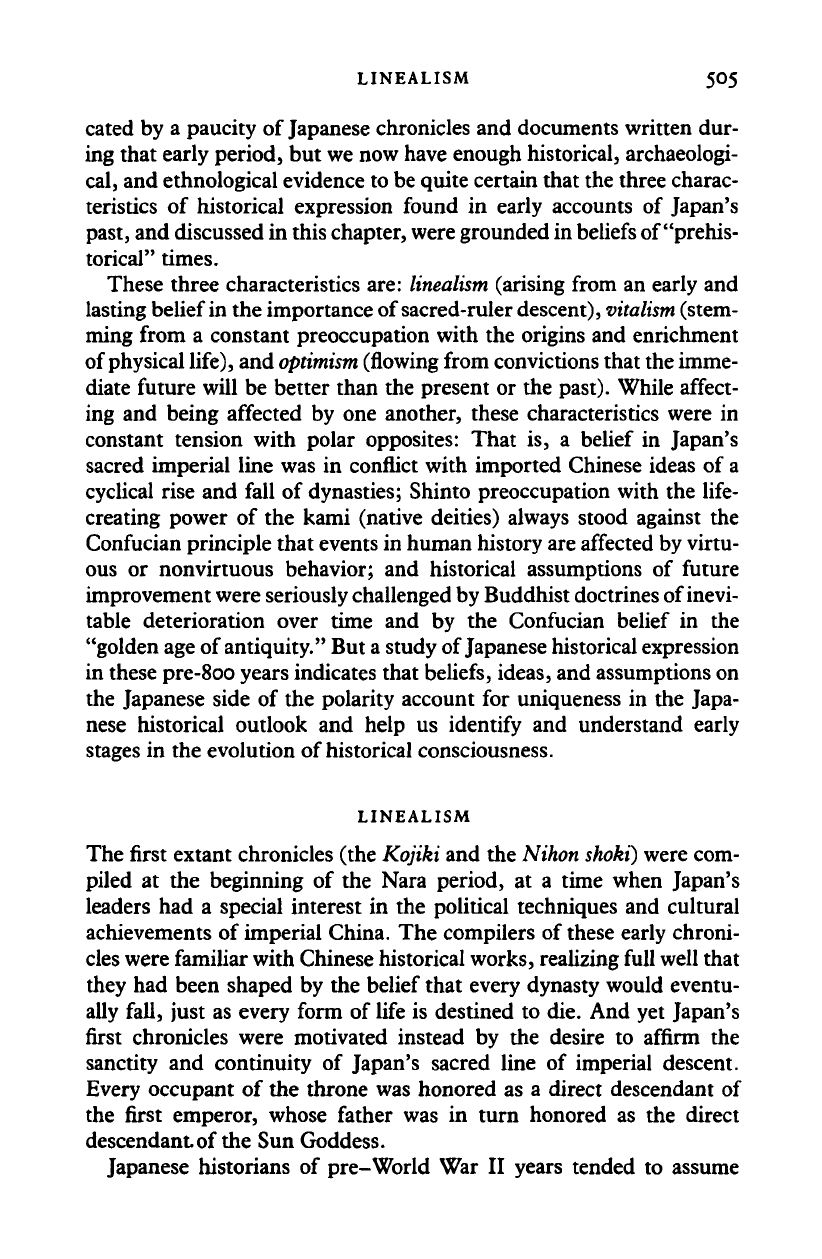
LINEALISM 505
cated by a paucity of Japanese chronicles and documents written dur-
ing that early period, but we now have enough historical, archaeologi-
cal,
and ethnological evidence to be quite certain that the three charac-
teristics of historical expression found in early accounts of Japan's
past, and discussed in this chapter, were grounded in beliefs of "prehis-
torical" times.
These three characteristics are:
linealism
(arising from an early and
lasting belief in the importance of sacred-ruler
descent),
vitalism
(stem-
ming from a constant preoccupation with the origins and enrichment
of physical life), and
optimism
(flowing from convictions that the imme-
diate future will be better than the present or the past). While affect-
ing and being affected by one another, these characteristics were in
constant tension with polar opposites: That is, a belief in Japan's
sacred imperial line was in conflict with imported Chinese ideas of a
cyclical rise and fall of dynasties; Shinto preoccupation with the life-
creating power of the kami (native deities) always stood against the
Confucian principle that events in human history are affected by virtu-
ous or nonvirtuous behavior; and historical assumptions of future
improvement were seriously challenged by Buddhist doctrines of inevi-
table deterioration over time and by the Confucian belief in the
"golden age of antiquity." But a study of Japanese historical expression
in these pre-800 years indicates that beliefs, ideas, and assumptions on
the Japanese side of the polarity account for uniqueness in the Japa-
nese historical outlook and help us identify and understand early
stages in the evolution of historical consciousness.
LINEALISM
The first extant chronicles (the Kojiki and the Nihon
skoki)
were com-
piled at the beginning of the Nara period, at a time when Japan's
leaders had a special interest in the political techniques and cultural
achievements of imperial China. The compilers of these early chroni-
cles were familiar with Chinese historical works, realizing full well that
they had been shaped by the belief that every dynasty would eventu-
ally fall, just as every form of life is destined to die. And yet Japan's
first chronicles were motivated instead by the desire to affirm the
sanctity and continuity of Japan's sacred line of imperial descent.
Every occupant of the throne was honored as a direct descendant of
the first emperor, whose father was in turn honored as the direct
descendant of the Sun Goddess.
Japanese historians of pre-World War II years tended to assume
Cambridge Histories Online © Cambridge University Press, 2008
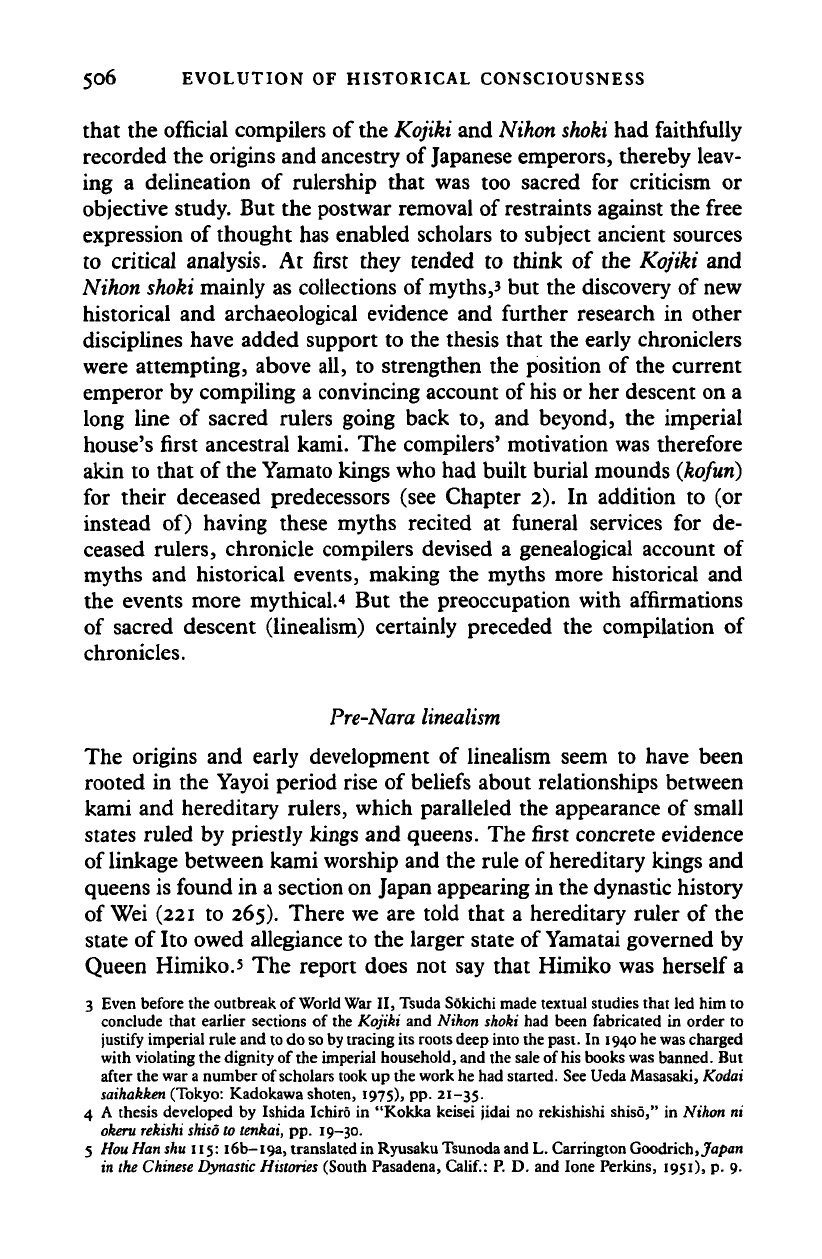
506 EVOLUTION OF HISTORICAL CONSCIOUSNESS
that the official compilers of the Kojiki and Nihon
shoki
had faithfully
recorded the origins and ancestry of Japanese emperors, thereby leav-
ing a delineation of rulership that was too sacred for criticism or
objective study. But the postwar removal of restraints against the free
expression of thought has enabled scholars to subject ancient sources
to critical analysis. At first they tended to think of the Kojiki and
Nihon
shoki
mainly as collections of
myths,
3
but the discovery of new
historical and archaeological evidence and further research in other
disciplines have added support to the thesis that the early chroniclers
were attempting, above all, to strengthen the position of the current
emperor by compiling a convincing account of his or her descent on a
long line of sacred rulers going back to, and beyond, the imperial
house's first ancestral kami. The compilers' motivation was therefore
akin to that of the Yamato kings who had built burial mounds
(kofuri)
for their deceased predecessors (see Chapter 2). In addition to (or
instead of) having these myths recited at funeral services for de-
ceased rulers, chronicle compilers devised a genealogical account of
myths and historical events, making the myths more historical and
the events more mythical.* But the preoccupation with affirmations
of sacred descent (linealism) certainly preceded the compilation of
chronicles.
Pre-Nara linealism
The origins and early development of linealism seem to have been
rooted in the Yayoi period rise of beliefs about relationships between
kami and hereditary rulers, which paralleled the appearance of small
states ruled by priestly kings and queens. The first concrete evidence
of linkage between kami worship and the rule of hereditary kings and
queens is found in a section on Japan appearing in the dynastic history
of Wei (221 to 265). There we are told that a hereditary ruler of the
state of Ito owed allegiance to the larger state of Yamatai governed by
Queen Himiko.s The report does not say that Himiko was herself a
3 Even before the outbreak of World War II, Tsuda Sokichi made textual studies that led him to
conclude that earlier sections of the Kojiki and Nihon
shoki
had been fabricated in order to
justify imperial rule and
to
do so by tracing its roots deep into the past. In
1940
he
was
charged
with violating the dignity of the imperial household, and the sale of
his
books
was
banned. But
after the war
a
number of scholars took up the work he had started. See Ueda Masasaki,
Kodai
saihakken
(Tokyo: Kadokawa shoten, 197s), pp. 21-35.
4 A thesis developed by Ishida Ichiro in "Kokka keisei jidai no rekishishi shiso," in Nihon m
okeru rekishi shiso to
tenkai,
pp. 19-30.
5
Hou Han shu
115:
l6b-l9a, translated in Ryusaku Tsunoda and L. Carrington Goodrich, Japan
in
the Chinese Dynastic Histories
(South Pasadena,
Calif.:
P. D. and lone Perkins, 1951), p. 9.
Cambridge Histories Online © Cambridge University Press, 2008
